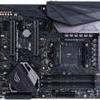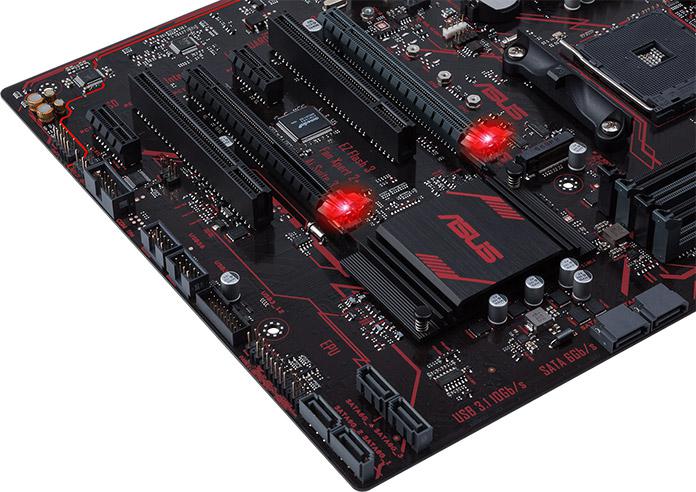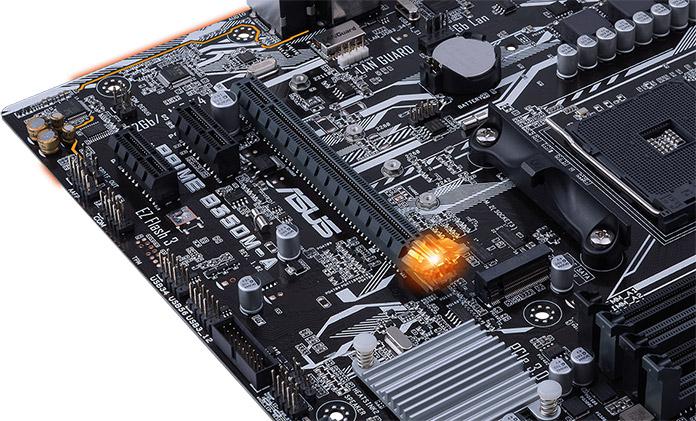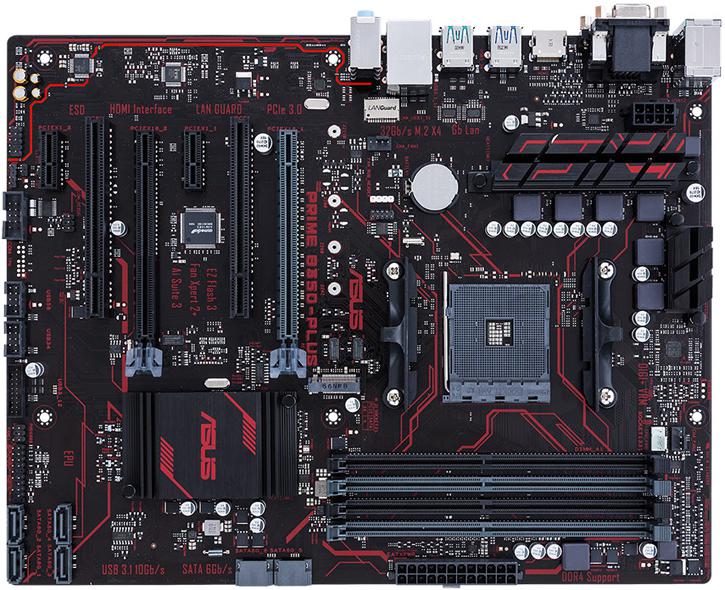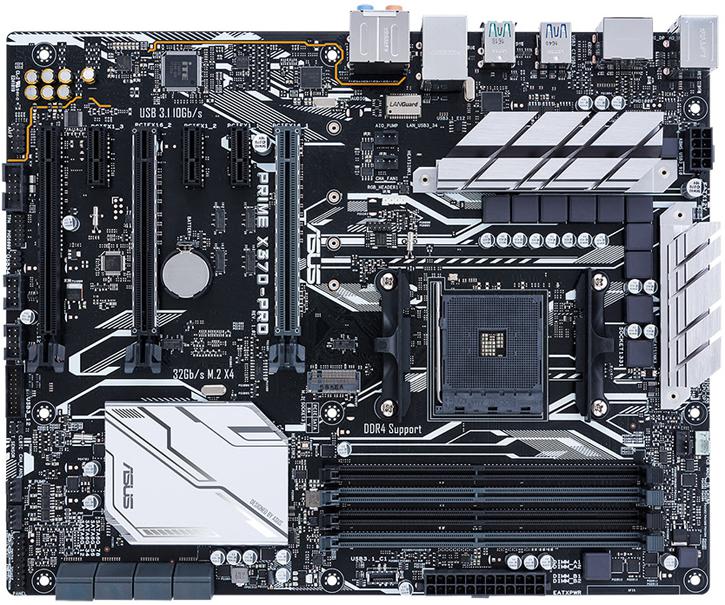ASUS has shared more details on their AM4 motherboards for AMD Ryzen processors. They will be releasing four models at launch inclusing two X370 and two B350 chipset based solutions.
Obviously the more popular one and most high-end version (at launch) is the Asus ROG Crosshair VI Hero using AMD's X370 chipset. This board will support 2-way SLI and CrossFireX (with dual SafeSlot), and is designed for easy CPU overclocking. ASUS will be offering the following boards including the microATX Prime B350M-A:
- Asus ROG Crosshair VI Hero ATX, US$254
- Asus PRIME X370-PRO ATX, US$169
- Asus Prime B350-Plus ATX, US$99
- Asus Prime B350M-A MicroATX, US$89
The Ryzen motherboards get paired obviously with lots of powerful CPU cores, a dual-channel DDR4 memory controller, and 16 PCI Express 3.0 lanes for graphics. But it also boasts expanded I/O in the form of integrated USB and storage controllers, including a quad-lane interface for NVMe SSDs. Bringing this connectivity into the processor puts devices in the center of the action—and frees them from sharing interconnect bandwidth with everything tied to the chipset.
There’s more to AM4 than just Ryzen. The socket will host upcoming 7th-generation A-series and Athlon processors. The A-series APUs incorporate Radeon integrated graphics, which is why most of our AM4 boards have display outputs. Like the Athlons, they’re capped at four CPU cores, eight PCIe lanes for discrete graphics, and two lanes for NVMe SSDs. The last couple of cutbacks hamper the bandwidth we can deliver on the motherboard, so some of the details on the following pages apply to Ryzen only. See the complete specifications on our product pages for a full rundown of the caveats when using A-series and Athlon processors.
The AM4 family shares a selection of chipset sidekicks that act as I/O hubs. These “south-bridge” components all have native USB 3.1 connectivity capable of hitting speeds up to 10Gbps; SATA ports that can be configured in RAID for added performance, redundancy, or both; and PCIe 2.0 lanes for slots and devices with lower bandwidth requirements. Bandwidth to the processor is more important, so the chipsets are linked to the CPU with a speedy four-lane PCIe 3.0 interconnect.
| X370 | B350 | A320 | |
|---|---|---|---|
| Overclocking | Y | Y | N |
| PCIe 3.0 x8/x8 | Y | N | N |
| PCIe 2.0 | 8 | 6 | 4 |
| USB 3.1 | 2 | 2 | 1 |
| USB 3.0 | 6 | 2 | 2 |
| USB 2.0 | 6 | 6 | 6 |
| SATA | 6 | 4 | 4 |
| RAID | 0,1,10 | 0,1,10 | 0,1,10 |
The X370 is the full-fat Frappuccino of the bunch. It’s the only one that unlocks Ryzen’s ability to split PCIe lanes between a pair of x16 slots for double-barreled SLI or CrossFireX. Teaming GPUs is practically required for 4K gaming at 60 FPS and max settings, and it can help smooth out demanding VR experiences and saturate ultra-high-refresh gaming monitors. The X370 also has more PCIe for additional slots and devices, more SATA ports for bigger RAID arrays, and more USB for extra peripherals.
Overclocking is another high-profile feature, but it’s not an exclusive. The X370 and its scaled-back B350 sibling can both exploit Ryzen’s OC-friendly unlocked multiplier to push your CPU to its limits. They both have dual USB 3.1 ports, as well, but the B350 drops a handful of PCIe lanes and I/O ports, making it more appropriate for modest builds.
Dialing back to the A320 takes overclocking off the table and cuts the I/O even further. This chipset is meant for entry-level systems, and we’re not sharing details about our associated motherboards just yet. We do, however, have lots to say about what’s going into the new boards based on the other chipsets.
The table below compares key specifications, and we take a detailed look at each board on the following pages. Click the model name to jump to the corresponding page for that board.
| ROG Crosshair VI Hero | Prime X370-Pro | Prime B350-Plus | Prime B350M-A | |
|---|---|---|---|---|
| Size | ATX | ATX | ATX | microATX |
| Chipset | X370 | X370 | B350 | B350 |
| Memory | 4 x DDR4 up to 3200 (OC) | 4 x DDR4 up to 3200 (OC) | 4 x DDR4 up to 3200 (OC) | 4 x DDR4 up to 3200 (OC) |
| Multi-GPU | CrossFireX 2 x SLI |
CrossFireX 2 x SLI |
CrossFireX | NA |
| PCIe | 2 x16 3.0 1 x16 2.0 3 x1 2.0 |
2 x16 3.0 1 x16 2.0 3 x1 2.0 |
1 x16 3.0 1 x16 2.0 2 x1 2.0 |
1 x16 3.0 2 x1 2.0 |
| M.2 | 1 x4/SATA | 1 x4/SATA | 1 x4/SATA | 1 x4/SATA |
| SATA | 8 | 8 | 6 | 6 |
| Ethernet | Intel | Intel | Realtek | Realtek |
| Audio | SupremeFX S1220 |
S1220A | 887-VD2 | 887-VD2 |
| USB 3.1 | 1 x front 1x Type-C 1 x Type-A |
1 x front 2 x Type-A |
2 x Type-A | 2 x Type-A |
| Display | N | Y | Y | Y |
| Aura | Chipset, 2 x strip | 1 x strip | NA | NA |
| Price | $254.99 USD $328.99 CAD |
$169.99 USD $218.99 CAD |
$99.99 USD $139.99 CAD |
$89.99 USD $119.99 CAD |
It’s difficult to summarize everything in table form, especially since raw specifications fail to fully capture a motherboard’s character. The Crosshair VI Hero and Prime X370-Pro, for example, differ much more than their few disparate specs suggest.
Crosshair VI Hero
Based on the top-of-the-line X370 chipset, the Crosshair supports two-way SLI and CrossFireX configs split between its main PCI Express x16 slots. Both have full SafeSlot reinforcement to withstand the weight of high-end cards. They’re also widely spaced to provide plenty of breathing room for air cooling. To complete the package, we include a high-bandwidth SLI bridge primed for a 3D-printed cover.
The board is designed for easy overclocking whether you’re a novice or expert. It incorporates full auto-tuning for the CPU, plus all our Fan Xpert enhancements for cooling. Liquid cooling gets some extra love thanks to headers for a flow tachometer and temperature in/out sensors. Those additions build upon a stacked foundation that includes one 3A header for dedicated pumps or finger-munching industrial fans, one 1A header for AIO water coolers, and five more for traditional CPU and system fans. The Crosshair VI Hero is equipped to drive formidable cooling configs right out of the box. You can add the latest NVMe SSDs with up to four lanes of PCI Express 3.0. Some of those drives can run warm enough to induce throttling under extreme workloads, so the slot is located in the bottom corner of the motherboard, away from hot spots around the CPU and graphics card. The placement alone improves thermals, and even better cooling is possible with our 3D-printed fan mount.
The Crosshair’s SupremeFX audio features an ASUS-exclusive S1220 codec that improves input quality for streamers with an industry-leading 113-dB SNR for the line-in. We’ve paired the chip with a premium ESS Sabre DAC and a collection of other enhancements along the audio chain to produce output good enough to make most people forgo a discrete sound card. On top of that, our Sonic Studio III software makes it easy to map audio streams to different outputs.
Gigabit Ethernet is provided by an Intel controller backed by GameFirst software that intelligently manages packets to prevent streaming and downloads from lagging your gaming. There’s also an M.2 slot primed for mini Wi-Fi cards. That lives in the rear I/O cluster alongside handy CMOS reset and BIOS Flashback buttons. You also get enough USB ports for a collection of game controllers and VR hardware, including 10Gbps USB 3.1 ports in Type-A and reversible Type-C flavors, plus an internal header for front-panel connectivity.
|
ROG Crosshair VI Hero | |
|---|---|
| Size | ATX |
| Chipset | AMD X370 |
| Memory | 4 x DDR4 up to 3200 (OC) |
| Multi-GPU | CrossFireX, 2 x SLI |
| Expansion | PCIe 3.0 x16 (CPU): 2 (x16/x0, x8/x8) PCIe 2.0 x16 (Chipset): 1 (up to x4) PCIe 2.0 x1 (Chipset): 3 |
| Storage | 1 x M.2 (NVMe x4 or SATA 6Gbps) 8 x SATA 6Gbps |
| Networking | Intel Gigabit Ethernet M.2 slot for Wi-Fi |
| Audio | SupremeFX S1220 |
| USB | 3.1: 1 x front, 1 x Type-C, 1 x Type-A 3.0: 2 x front, 8 x Type-A 2.0: 2 x front, 4 x Type-A |
| Aura | Chipset + 2 x strip headers |
| Price | $254.99 USD $328.99 CAD |
Gigabit Ethernet is provided by an Intel controller backed by GameFirst sof
The Prime X370-Pro is a potent professional
While the black-and-white styling sets a more professional tone, that doesn’t mean the board doesn’t know how to have fun. The Aura RGB lighting is a perfect example. The PCB is free of multi-colored LEDs, establishing a stealthy default. But it also has a four-pin header for light strips up to two meters long, so you can illuminate a full system if you want. Thanks to AMD’s flagship X370 chipset, the Prime X370-Pro can harness the formidable graphics power of two-way SLI and CrossFireX setups. Both of the PCIe x16 slots tied to the CPU have full SafeSlot reinforcement and wide spacing for maximum airflow. The other slot of note is the four-lane M.2 nestled below the AM4 socket. The direct connection to the CPU lets cutting-edge NVMe SSDs bask in 32Gbps of glorious bandwidth—and hit phenomenal read and write speeds. You can connect more SSDs and hard drives via eight SATA ports lining the edge. USB 3.1 is available in three flavors: traditional Type-A and reversible Type-C at the rear, plus an internal header for whatever you want to hook up at the front. The Prime also adds DisplayPort and HDMI outputs for 7th-generation A-series and Athlon processors with integrated Radeon graphics. Ryzen CPUs can be overclocked with a single click using the board’s 5-Way Optimization routine or the extensive manual controls. Fan Xpert 4 provides full control over system cooling whether you’re on air, liquid, or a combination of the two. There are four fan headers onboard, plus one tuned for all-in-one liquid coolers, and another for high-amperage pumps and fans.
The onboard audio uses an S1220A codec with the same 113-dB input SNR and 120-dB output SNR found on the ROG Crosshair VI Hero. While the Prime lacks that model’s full SupremeFX package, you still get premium capacitors and automatic impedance sensing for headphones. Networking is handled by the same Intel Gigabit Ethernet NIC in the Crosshair, this time with Turbo LAN software to intelligently manage packet delivery.
|
Prime X370-Pro | |
|---|---|
| Size | ATX |
| Chipset | AMD X370 |
| Memory | 4 x DDR4 up to 3200 (OC) |
| Multi-GPU | CrossFireX, 2 x SLI |
| Expansion | PCIe 3.0 x16 (CPU): 2 (x16/x0, x8/x8) PCIe 2.0 x16 (Chipset): 1 (up to x4) PCIe 2.0 x1 (Chipset): 3 |
| Storage | 1 x M.2 (NVMe x4 or SATA 6Gbps) 8 x SATA 6Gbps |
| Networking | Intel Gigabit Ethernet |
| Audio | Realtek S1220A |
| USB | 3.1: 1 x front, 2 x Type-A 3.0: 2 x front, 1 x Type-C, 5 x Type-A 2.0: 4 x front |
| Display | DisplayPort 1.2, HDMI 1.4b |
| Aura | 1 x strip header |
| Price | $169.99 USD $218.99 CAD |
Prime B350-Plus
Ryzen maintains AMD’s commitment to offering phenomenal performance and value at lower prices, and the Prime B350-Plus embodies that spirt. You get all the essentials for a solid AM4 build for just under $100. The Prime B350-Plus supports Ryzen processors all the way up to the top eight-core beasts. Overclocking the CPU manually is easy thanks to AMD’s decision to unlock the multipliers across the whole family, and the board still supports up to 64GB of DDR4 memory at speeds up to 3200MHz.
Cooling management takes a step back to Fan Xpert 2+, which retains intelligent speed control but loses recent enhancements like GPU temperature sensing and multi-sensor grouping. Our latest liquid-specific tweaks are also missing, but you can easily configure one of the three onboard fan headers to drive an AIO cooler. As an added bonus, there’s an extra header for the lighting in AMD’s RGB-infused AM4 cooler.
Onboard lighting manifests in red accents on the PCIe x16 slots. They nicely complement the blood-on-black colorway we popularized for PC gaming hardware. Both x16s have SafeSlot Core strengthening, but only the top one carries PCI Express 3.0 signals from the CPU. Although the board and accompanying B350 chipset are geared toward single-GPU systems, you can pair a couple of Radeons in CrossFireX using the second x16 slot, which has four lanes of PCIe from the chipset.
While the board’s B350 chipset somewhat limits I/O, there are no restrictions on CPU-connected storage. Like its high-end siblings, the Prime B350-Plus features a four-lane M.2 slot compatible with the fastest consumer-grade NVMe SSDs around. There’s enough room for drives up to 110 mm, adding a measure of future-proofing in case SSD makers decide to go long.
|
Prime B350-Plus | |
|---|---|
| Size | ATX |
| Chipset | AMD B350 |
| Memory | 4 x DDR4 up to 3200 (OC) |
| Multi-GPU | CrossFireX |
| Expansion | PCIe 3.0 x16 (CPU): 1 PCIe 2.0 x16 (Chipset): 1 (up to x4) PCIe 2.0 x1 (Chipset): 2 PCI: 2 |
| Storage | 1 x M.2 (NVMe x4 or SATA 6Gbps) 6 x SATA 6Gbps |
| Networking | Realtek Gigabit Ethernet |
| Audio | Realtek 887-VD2 |
| USB | 3.1: 2 x Type-A 3.0: 2 x front, 4 x Type-A 2.0: 4 x front, 2 x Type-A |
| Display | HDMI 1.4b, DVI-D, VGA |
| Aura |
NA |
microATX on the Prime B350M-A
A single graphics card is typically enough even for serious gaming, and improved onboard peripherals have largely removed the need for additional expansion cards. Our Prime B350M-A brings Ryzen and its AM4 counterparts to a microATX form factor that squeezes into tighter spaces.
The board straddles two worlds despite its smaller footprint. It’s part of our business-friendly Corporate Stable Motherboard program, which ensures a steady supply for one year in addition to free advance replacement to minimize downtime. For less buttoned-down builds, manual overclocking options let you exploit the processor’s unlocked multiplier.
Gamers can plug full-sized graphics cards into the single x16 slot, which is tightly anchored to the board with SafeSlot Core reinforcement. The Prime B350M-A is unlikely to be paired with ultra-high-end graphics cards with ginormous coolers, so the full treatment isn’t necessary. We have, however, added a touch of lighting to the retention tab that matches the illumination behind the audio circuitry. It’s a little hint of flair for the lower-key design.
The onboard audio matches the full-sized Prime B350-Plus, as does the networking. And the same goes for the memory and storage. You get four DDR4 DIMM slots and a quad-lane M.2 that supports the latest NVMe SSDs at full length. Connectivity covers all the bases with a pair of 10Gbps USB 3.1 connectors, a trio of display outs, and an ample selection of SATA and USB ports.
Fan Xpert intelligence keeps the cooling quiet by only ramping up fans when required. There are two headers onboard, and you can profile the fans connected to both with a single click for easy calibration. The CPU fan header also has a three-pin sidekick for the RGB heatsink that ships with some of AMD’s AM4 CPUs.
|
Prime B350M-A | |
|---|---|
| Size | microATX |
| Chipset | AMD B350 |
| Memory | 4 x DDR4 up to 3200 (OC) |
| Multi-GPU | NA |
| Expansion | PCIe 3.0 x16 (CPU): 1 PCIe 2.0 x1 (Chipset): 2 |
| Storage | 1 x M.2 (NVMe x4 or SATA 6Gbps) 6 x SATA 6Gbps |
| Networking | Realtek Gigabit Ethernet |
| Audio | Realtek 887-VD2 |
| Audio | Realtek 887-VD2 |
| Display | HDMI 1.4b, DVI-D, VGA |
| USB | 3.1: 2 x Type-A 3.0: 2 x front, 4 x Type-A 2.0: 4 x front |
| Aura | NA |
